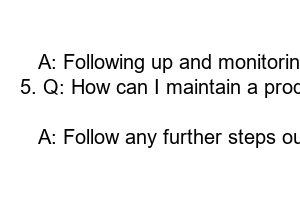무실적 부가세신고 방법
**How to Report Non-Performance at Work**
Reporting non-performance at work can be a challenging task, but it is essential for maintaining a productive and efficient work environment. Whether it be a coworker who is not pulling their weight or a team member who consistently misses deadlines, addressing non-performance is crucial for the success of the team. In this blog post, we will discuss some tips on how to effectively report non-performance at work.
**Identify the Issue**
Before reporting non-performance, it is important to first identify the issue at hand. Take note of specific instances where the individual’s performance fell short or where they did not meet expectations. Be prepared to provide examples and evidence to support your claims.
Identifying the issue is the first step in addressing non-performance at work. It is essential to gather all necessary information and documentation to support your case before taking further action.
**Address the Issue Directly**
Once you have identified the issue, it is important to address it directly with the individual in question. Schedule a meeting to discuss your concerns and provide them with the opportunity to explain their side of the story. **Avoid beating around the bush and be straightforward in your communication.**
Addressing the issue directly with the individual in question is crucial in resolving non-performance at work. By having an open and honest conversation, you can work together to find a solution to the problem.
**Document Everything**
Throughout the process of addressing non-performance, it is essential to document everything. Keep detailed notes of all interactions, meetings, and any follow-up actions taken. **Documenting everything will help you build a solid case if further action is required.**
Documenting everything is crucial in the process of addressing non-performance at work. By keeping detailed records, you can provide evidence to support your claims and show a pattern of behavior.
**Seek Support from HR**
If the issue persists despite your efforts to address it directly, it may be necessary to seek support from HR. HR can provide guidance on how to handle the situation and may be able to facilitate a resolution. **Seeking support from HR can help ensure that the issue is handled in a fair and professional manner.**
Seeking support from HR is an important step in addressing non-performance at work. HR can provide valuable advice and assistance in resolving the issue effectively and efficiently.
**Follow Up and Monitor Progress**
After addressing the issue and seeking support from HR, it is important to follow up and monitor progress. Continue to document any improvements or setbacks and provide feedback to the individual as needed. **Following up and monitoring progress will help ensure that the issue is resolved satisfactorily.**
Following up and monitoring progress is essential in effectively addressing non-performance at work. By staying engaged and providing feedback, you can help the individual improve their performance and prevent future issues.
**Summary**
Addressing non-performance at work can be a difficult but necessary task. By identifying the issue, addressing it directly, documenting everything, seeking support from HR, and following up and monitoring progress, you can effectively address non-performance in the workplace.
**FAQs**
1. Q: What should I do if my coworker is consistently underperforming?
A: Address the issue directly with your coworker and seek support from HR if needed.
2. Q: How can documenting everything help in addressing non-performance?
A: Documenting everything provides evidence to support your claims and show a pattern of behavior.
3. Q: What should I do if the issue persists despite my efforts?
A: Seek support from HR for guidance on how to handle the situation professionally.
4. Q: Why is following up and monitoring progress important?
A: Following up and monitoring progress helps ensure the issue is resolved satisfactorily and prevents future problems.
5. Q: How can I maintain a productive work environment while addressing non-performance?
A: By addressing issues directly, seeking support when needed, and providing feedback and guidance to the individual.
6. Q: What should I do if the individual’s performance does not improve?
A: Follow any further steps outlined by HR and consider additional actions that may be necessary to address the issue effectively.

